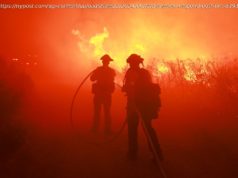Martin McGuinness, the Irish Republican Army commander who led his paramilitary movement toward reconciliation with Britain, has died, his Sinn Fein party says.
A look at all the changes that have been made under Trump’s administration so far.
Martin McGuinness (Daniel Leal-Olivas, AFP)
Multimedia · User Galleries · News in Pictures Send us your pictures · Send us your stories
Dublin – Martin McGuinness, the Irish Republican Army
commander who led his underground, paramilitary movement toward reconciliation
with Britain, and was Northern Ireland’s deputy first minister for a decade in
a power-sharing government, has died, his Sinn Fein party announced Tuesday on
Twitter. He was 66.
The party said he died after a short illness. He suffered
from amyloidosis, a rare disease with a strain specific to Ireland’s northwest.
The chemotherapy required to combat the formation of organ-choking protein
deposits quickly sapped him of strength and forced him to start missing
government appointments.
McGuinness’s transformation as peacemaker was all the more
remarkable because, as a senior IRA commander during the years of gravest
Catholic-Protestant violence, he insisted that Northern Ireland must be forced
out of the United Kingdom against the wishes of Protestants.
Even after the Sinn Fein party – the IRA’s legal, public
face – started to run for elections in the 1980s, McGuinness insisted as Sinn
Fein deputy leader that « armed struggle » remained essential.
« We don’t believe that winning elections and any amount
of votes will bring freedom in Ireland, » he told a BBC documentary team in
1986. « At the end of the day, it will be the cutting edge of the IRA that
will bring freedom. »
Yet within a few years of making that stubborn vow, McGuinness
was exploring the opposite option in covert contacts with British intelligence
that led eventually to a truce, inter-party talks and the installation of the
IRA icon in the heart of Northern Ireland’s government.
‘A mass killer’
Irish Times columnist Fintan O’Toole argued in January 2017
that McGuinness had been « a mass killer – during his period of membership
and leadership the IRA killed 1 781 people, including 644 civilians – whose
personal amiability has been essential to the peace process. If he were not a
ruthless and unrepentant exponent of violence, he would never have become such
a key figure in bringing violence to an end. »
Unlike his close Belfast associate, Sinn Fein leader Gerry
Adams, McGuinness never hid the fact that he had been a commander of the IRA –
classed as a terrorist organisation by the British, Irish and US governments.
Nor could he.
Born May 23, 1950, he joined the breakaway Provisional IRA
faction in his native Londonderry – simply Derry to Irish nationalists – after
dropping out of high school and working as an apprentice butcher in the late
1960s. At the time, the Catholic civil rights movement faced increasing
conflict with the province’s Protestant government and police.
He rose to become Derry’s deputy IRA commander by age 21 as
« Provo » bombs systematically wrecked the city centre. Soldiers found
it impossible to pass IRA road barricades erected in McGuinness’s nearby
Bogside power base.
McGuinness appeared unmasked at early Provisional IRA press
conferences. The BBC filmed him walking through the Bogside discussing how the
IRA command structure worked and stressing his concern to minimise civilian
casualties, an early sign of public relations savvy.
Sinn Féin Leader and former Deputy First Minister Martin McGuiness dies after short illness https://t.co/OvB8BMQhxZ pic.twitter.com/1xlbkFqiMt
Arrest
In 1972, Northern Ireland’s bloodiest year, McGuinness
joined Adams in a six-man IRA delegation flown by the British government to
London for secret face-to-face negotiations during a brief truce. Those talks
got nowhere and McGuinness went back on the run until his arrest on New Year’s
Eve in the Republic of Ireland near a car loaded with 110 kilograms of
explosives and 4 750 rounds of ammunition.
During one of his two Dublin trials for IRA membership,
McGuinness declared from the dock he was « a member of the Derry Brigade of
the IRA and I’m very, very proud of it ».
Historians and security analysts agree that McGuinness was
promoted to the IRA’s ruling army council following his November 1974 parole
from prison and would have overseen many of the group’s most spectacular and
divisive attacks. These included bomb attacks on London tourist spots and the
use of « human bombs » – civilian employees like cooks and cleaners at
British security installations – who were forced to drive car bombs to their
places of work and were detonated by remote control before they could raise the
alarm.
His central role in the IRA command was underscored when
Britain in 1990 opened secret dialogue with the underground group in hopes of
securing a ceasefire. An MI6 agent codenamed « The Mountain Climber »
met McGuinness several times as part of wider diplomatic efforts that delivered
a 1994 IRA truce and, ultimately, multi-party negotiations on Northern
Ireland’s future and the US-brokered Good Friday peace accord of 1998.
Northern Ireland’s first power-sharing government, formed in
1999, was led by moderates and afforded only minor roles for Sinn Fein and the
most uncompromising Protestant party, Paisley’s Democratic Unionists. When Sinn
Fein nominated McGuinness to be education minister, many Protestant lawmakers
recoiled and insisted they would never accept what one called « an IRA
godfather » overseeing their children’s education.
That first coalition collapsed under the twin weight of
Paisley-led obstruction and the IRA’s refusal to disarm as the Good Friday pact
intended. McGuinness served as the lead liaison with disarmament officials.
After election results vaulted the Democratic Unionists and
Sinn Fein to the top of their communities for the first time, pressure mounted
on the IRA to surrender its stockpiled arsenal. This happened in 2005, paving
the way for Paisley to bury the hatchet with the group he called « the
Sinners ».
Unlikely friendship
No observer could have foreseen what happened next: a
genuine friendship between First Minister Paisley and Deputy First Minister
McGuinness.






